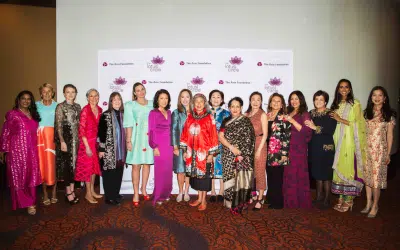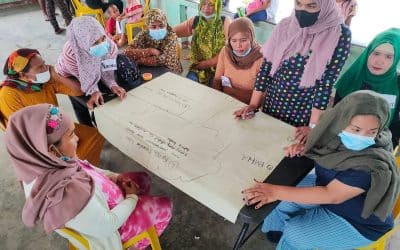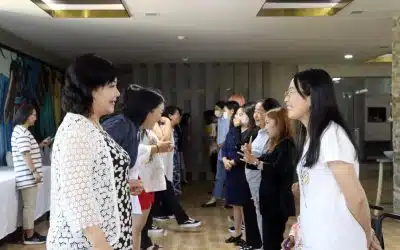InAsia
Insights and Analysis
China’s Domestic Violence Law Turns Four
April 1, 2020
On November 25, 2019—International Day for the Elimination of Violence against Women—a famous Chinese beauty vlogger named Yuya bravely faced the camera and told her story of abuse by her former partner. In a 12-minute documentary-style video on Weibo, China’s social media platform, Yuya is seen lying on the floor of an elevator, desperately struggling and crying out as a man drags her forcibly from the lift. The hashtag she created, #NoLongerSilentFacedWithDV, quickly went viral, drawing 810,000 user messages about domestic violence.
On March 1, China’s Domestic Violence Law turned four years old. It’s a mixed bag for victims. The law’s definition of domestic violence (DV) covers both physical and psychological violence, but it does not explicitly include sexual violence such as marital rape, or economic control such as being deprived of financial resources, which are equally prevalent and internationally recognized forms of DV. The law covers married couples, cohabitating partners, and other family members, but it does not include violence against former spouses or intimate partners who do not live together, and it leaves some ambiguity when it comes to same-sex partners.

Police station of Ping Wu County, MianYang City, China. On March 1, China’s Domestic Violence Law turned four years old. (Photo: Dailin / Shutterstock)
The DV law establishes special protections for victims who are underage, elderly, disabled, pregnant or lactating, or seriously ill (Article 5). It stipulates that public security agencies must issue warning letters to minor offenders (Article 16), and, to date, eight provincial governments have developed standards and procedures for doing so, and police in most provinces have issued written warnings to DV perpetrators. It also allows victims of threats or violence to seek protection orders from the people’s courts (Article 23). By December 2019, the courts in China had issued 5,749 protection orders for DV victims, and the number of protection orders has increased, year by year, from 687 in 2016 to 2,004 in 2019. According to the Prosecutor General’s Office, some 5,134 people were prosecuted for DV crimes in 2016. The latest data from the Ministry of Public Security shows that the police stopped or prevented more than six million incidents of DV in the past four years.
The influence of the DV law has spread steadily since its adoption four years ago.
The influence of the DV law has spread steadily since its adoption. Several agencies at the national level, including the Ministry of Justice and the Supreme People’s Court, have handed down regulations and policies on DV, addressing child protection, legal assistance, and protection orders, and sorting out interlocking jurisdictions. By November 2019, the various levels of governments in 24 provinces, municipalities, and autonomous regions had issued directives on aspects of the DV Law, including guidelines for warning letters, protection orders, and mandatory reporting. As of March 2020, the People’s Congress in the four provinces of Shandong, Hunan, Hubei, and Guizhou had enacted their own provincial-level anti-DV regulations.
Despite the considerable progress since 2016, however, there are many challenges still ahead.
Despite the considerable progress since 2016, however, there are many challenges still ahead. There are still no comprehensive national implementation guidelines or judicial interpretations for the DV law, urgently needed to address uncertainties in defining and recognizing DV and to standardize procedures for protecting victims.
The DV law requires educational, medical, and social-welfare institutions to report to the public security departments when people who are unable to care for themselves become victims (Articles 14 and 35), but the reporting mechanisms are still unclear, and the mandate has been applied mostly to left-behind children or children in difficult circumstances, instead of covering all minors and other vulnerable groups like people with mental disabilities.
Protection orders and warning letters are also underutilized. Data on the number of warning letters issued in each province and their effectiveness is fragmented and incomplete, and the courts granted motions for protection orders just 63 percent of the time in 2018. An analysis of 560 written judgements found that DV victims often have difficulty meeting the court’s evidentiary requirements, and that judges don’t fully understand this important legal tool.
This points to another big challenge—the lack of awareness and capacity among frontline anti-DV service providers. Police officers without specialized training, for example, often regard DV as a “minor issue.” Police training programs offer limited guidance on DV case management. Existing DV shelters are chronically underused due to a shortage of trained counsellors and legal staff.
The DV law encourages a coordinated effort by multiple stakeholders to tackle DV. It acknowledges civil society organizations (CSOs) as key players in raising public awareness, providing direct services to DV victims, and monitoring and evaluating law enforcement. But a 2018 mapping study by The Asia Foundation and the Wo Qi Foundation found that most anti-DV CSOs are located in urban areas in eastern and central China. Only 17 CSOs, just 23 percent of those surveyed, could provide services to victims in rural areas in the underdeveloped western provinces. Anti-DV CSOs were found to serve primarily women and children, and little support was available for other vulnerable groups. Standard procedures and best practices for DV case management were too often lacking.
The Asia Foundation has responded to these challenges with several projects since 2018 to improve implementation of the DV law and protect the rights of victims, including the most marginalized groups, by building the capacity of Chinese CSOs, developing anti-DV technical tools, and advocating for a better policy environment.
By September 2019, the Foundation and its local partners had conducted training workshops for 246 participants from 98 CSOs, and 18 webinar sessions that reached 3,955 CSO practitioners across China. The training covered gender equality, victim-centered interventions, DV among marginalized groups, DV case management, and other topics.
The Foundation also worked with local partners to propose implementation guidelines for the DV law and supported the development of an intimate-partner danger-assessment tool for governments and CSOs to screen for DV and better serve victims.
The Foundation is currently supporting 12 CSOs, whose work includes DV issues for women with disabilities, migrant women, children, and LGBT groups, and we are building an online resource center for CSOs and professionals to exchange knowledge and resources and build their fundraising capacity.
Yuya’s ex-partner got 20 days in administrative detention for his threats and violence. The local court in Chongqing also granted Yuya a protection order. While some observers were disappointed by the lenient punishment, due to insufficient evidence of severe physical injury, Yuya’s brave public testimony called the public’s attention to the dark shadow of DV, and more survivors are speaking up. Her story also shines a light on the obstacles that DV victims face and the important issues that China still must grapple with to protect the victims of domestic violence.
Yang Hao is a program officer for The Asia Foundation’s Gender Equality Program in China. She can be reached at [email protected]. The views and opinions expressed here are those of the author, not those of The Asia Foundation.
About our blog, InAsia
InAsia is posted and distributed every other Wednesday evening, Pacific Time. If you have any questions, please send an email to [email protected].
Contact
For questions about InAsia, or for our cross-post and re-use policy, please send an email to [email protected].The Asia Foundation
465 California St., 9th Floor
San Francisco, CA 94104
The Latest Across Asia
News
April 25, 2024
Program Snapshot
April 18, 2024
News
April 17, 2024

2024 Lotus Leadership Awards
The Lotus Leadership Awards recognize contributions towards gender equality in Asia and the Pacific







0 Comments